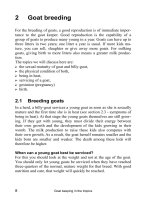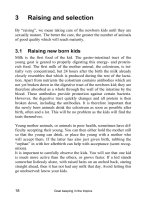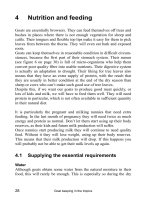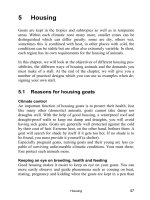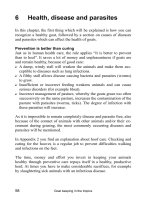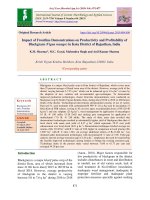Adoption of scientific health care practices of goat owners in Chittorgarh district of Rajasthan, India
Bạn đang xem bản rút gọn của tài liệu. Xem và tải ngay bản đầy đủ của tài liệu tại đây (152.85 KB, 5 trang )
Int.J.Curr.Microbiol.App.Sci (2018) 7(7): 2220-2224
International Journal of Current Microbiology and Applied Sciences
ISSN: 2319-7706 Volume 7 Number 07 (2018)
Journal homepage:
Original Research Article
/>
Adoption of Scientific Health Care Practices of Goat Owners
in Chittorgarh District of Rajasthan, India
Anil Mordia1*, M.C. Sharma2 and Sunil Kumar2
1
Livestock Research Station, Dag, Jhalawar, India
Department of Livestock Production Management, College of Veterinary and Animal
Science, Navania, Udaipur-313601, Rajasthan University of Veterinary and Animal Sciences,
Bikaner-334001, Rajasthan, India
2
Corresponding author
ABSTRACT
Keywords
Adoption, Goat
owners, Health
care, Practices,
Chittorgarh and
Rajasthan
Article Info
Accepted:
17 June 2018
Available Online:
10 July 2018
Livestock play a vital role in the agriculture and rural economics of the developing world.
Animal husbandry is a major economic activity of the rural peoples, especially in the
Chittorgarh district of Southern Rajasthan. A field survey was conducted to study adopted
scientific goat health care practices of 120 respondents of 8 villages of Chittorgarh and
Kapasan tehsils of Chittorgarh district of Rajasthan were interviewed. Adoption is a mental
process and depends on many factors viz., awareness knowledge, innovativeness and
characteristics of an innovations etc. The study revealed that high adoption was noticed in
practicing isolation of sick animals from flock was obtained overall first rank with 81.94
MPS. In which level of adoption Chittorgarh tehsil obtained first rank with 95.56 MPS and
Kapasan tehsil obtained second rank with 68.33 MPS in the study area. The disposal of
placenta by recommended method obtained overall second rank with 73.89 MPS in which
level of adoption Chittorgarh tehsil obtained third rank with 73.89 MPS and Kapasan tehsil
obtained first rank with 73.89 MPS in all categories. The overall third rank was obtained
by control of in house flies/mosquitoes by suitable disinfectants with 67.78 MPS. Lower
adoption was found that Grooming practice for protection of goat from parasites obtained
thirteenth in the priority of adoption with 33.61 MPS respectively in the study area.
Introduction
Livestock sector is significantly contributing
to the national economy and its growth rate is
continuously increasing.
Livestock sector constitutes an important
component of agricultural economy of
developing countries, a contribution that goes
beyond direct food production and includes
multipurpose products and uses, such as skin,
feather, fibre, manure for fertilizer and fuel,
power and transportation, as barter product in
societies where there is no circulation of
currency (Satyanarayan et al., 2010).
Animal husbandry is a major economic
2220
Int.J.Curr.Microbiol.App.Sci (2018) 7(7): 2220-2224
activity of the rural peoples, especially in the
Chittorgarh district of Southern Rajasthan.
Development of livestock sector has a
significant beneficial impact in generating
employment and reducing poverty in rural
areas. More than 80 per cent rural families
keep livestock in their households.
Contribution of animal husbandry sector to the
GDP of the state has been estimated to be
around 9.16 per cent. About 35 per cent of the
income to small and marginal farmers comes
from dairy and animal husbandry (SourceAnimal Husbandry Department, Rajasthan
2016).
The world population of goat is estimated to
be 921 million (UN Food and Agriculture
Organization, FAOSTAT-2012). More than 95
per cent of the goat population is found in
developing countries. In terms of goat
population, India possesses 135.17 million
goats and contributes around 26.40 per cent of
total livestock population in the country,
ranking 2nd in the goat population of the world
(19th Livestock Censes -2012).
The total livestock population in Rajasthan is
about 577.32 lacs. In Rajasthan, the goat’s
population was 216.66 lac and contributes
around 37 per cent of total livestock
population in the Rajasthan (19th Livestock
Census Rajasthan-2012).
Research area Chittorgarh district has total
livestock population is 13, 77,269 lakh. In
Chittorgarh district total goat population is
4,74,799 and contributes around 34.47 per
cent (19th Livestock Census Rajasthan-2012).
In which Chittorgarh tehsil goat population is
70,328 and contributes around 14.81 per cent
whereas, Kapasan tehsil goat population is
64,165 and contributes around 13.52 per cent
(Farmers portal, Gram war population- 2012).
Hence, the present investigation was
undertaken to study the breeding and feeding
management practices among livestock
owners in Chittorgarh district of Rajasthan.
Materials and Methods
The present investigation was conducted to
study goat scientific health care practices of
120 respondents of 8 villages, VIZ., Keljer,
Phusariya, Nalda, Barsingh ka Gurha, Keerion
ka Khera, Theparion ka Khera, Moda Khera
and Samrathpura in Chittorgarh and Kapasan
tehsils of Chittorgarh district of Rajasthan
were selected using random sampling
technique. The interview schedule was pretested before applying it to the actual
respondents. After getting opinion of the goat
owners and expert advice the interview
schedule was modified and then finally used
for the study.
The data were collected through personal
interview of the goat owners with the help of
well-structured interview schedule. The
response to each of the questions in the
interview schedule was coded and tabulated
respondent-wise in a master table. The
qualitative data were quantified accordingly
and tabulated to draw meaningful inferences.
In the present study appropriate statistical
tools was applied. Tentatively it has been
planned to apply percentage and frequency,
mean, and mean per cent score, rank and chisquare test. Therefore, significance among the
different classes will be tested with chisquares test (Snedecor and Cochran, 1994).
Measurement of adoption
In the present study the term adoption
operationalized as the new practice
recommended by scientist after thorough
research for the benefit of goat owners.
Whether the goat owners using these
technologies over a period of time at the farm
or not. The selection of recommended housing
and management practices. The most
important recommended practices in each
2221
Int.J.Curr.Microbiol.App.Sci (2018) 7(7): 2220-2224
aspect were selected on the basis of highest
score points in order of merit.
According to selection of recommended
scientific housing and management practices,
an adoption schedule was developed.
The respondents were asked to give opinion
about adoption on the point’s continuum i.e.
fully, partially and least adopted the practice.
These three points were scored as 3, 2, and 1,
respectively.
To find out the level of adoption, overall score
for each respondent was calculated and
respondent were categorized into three groups
on the basis of overall score obtained by each
respondents;
Low level of adoption =
[X - S.D.]
Medium level of adoption = [X – S.D. to X
+ S.D.]
High level of adoption =
This part of chapter deals with the extent of
adoption of recommended goat scientific
housing and management practices of goats in
research area from 120 respondents are
summarized in following sub heads and details
information are presented in table 1. Adoption
is a mental process. In the modern era new
ideas are being invented by goat scientists but
all the innovations are not being adopted by
many of the members of a social system.
Adoption of an innovation depends on many
factors
viz.,
awareness
knowledge,
innovativeness and characteristics of an
innovations etc. Keeping this in mind an
attempt has been made to know the extent of
adoption of improved goat scientific housing
and management practices. The results are
presented in this section of report.
Adoption of health care practices perceived
by the respondents
[X + S.D.]
Frequency and percentage of respondents in
each category i.e., low, medium and high were
calculated. The adoption index for each
respondent was calculated by using the
following formula
Adoption index=
x 100
To determine the extent of adoption mean per
cent score for each sub-practice was worked
out and ranked accordingly. In order to find
out the difference in adoption level among
marginal goat owners, small goat owners and
large goat owners about different aspects of
scientific housing and management practices.
Results and Discussion
Adoption of recommended scientific health
care practices by the goat owners
The data presented in table 1 reveals that
overall first rank was obtained by practicing
isolation of sick animals from flock with 81.94
MPS. In which level of adoption Chittorgarh
tehsil obtained first rank with 95.56 MPS and
Kapasan tehsil obtained second rank with
68.33 MPS in the study area. The disposal of
placenta by recommended method obtained
overall second rank with 73.89 MPS in which
level of adoption Chittorgarh tehsil obtained
third rank with 73.89 MPS and Kapasan tehsil
obtained first rank with 73.89 MPS in all
categories.
Likewise, the adoption related control of in
house
flies/mosquitoes
by
suitable
disinfectants, regular control of ectoparasitic
by the recommended measures, uses of deworming against internal parasites as per
recommended, timely vaccination against
2222
Int.J.Curr.Microbiol.App.Sci (2018) 7(7): 2220-2224
contagious diseases, practicing recommended
method of disposal of carcass, proper care and
treatment of naval cord at recommended time,
practicing hair clipping at proper time, hoof
trimming at proper time, treatment of common
diseases of goat by veterinarians, use of
recommended scientific clean milking
procedure, grooming practices for protection
of goat from parasites were realized as level of
adoption by the respondents and ranked, third,
fourth, fifth, sixth, seventh, eighth, ninth,
tenth, eleventh, twelfth and thirteenth in the
priority of adoption with 67.78 MPS,65.83
MPS, 61.11 MPS, 58.61 MPS, 56.94 MPS,
55.28 MPS, 52.78 MPS, 48.89 MPS, 47.22
MPS and 41.67 MPS and 33.61 MPS
respectively in the study area. Lack of
awareness regarding grooming practices for
protection of goat from parasites had low
adoption in the study area. Rai et al., (2013)
reported that awareness of adoption levels
about improved goat rearing practices such as
de-worming and health care. Kumar et al.,
(2015) reported that health care practices had
lowest
mean
score
of
adoption.
Table.1 Adoption of scientific health care practices by the goat owners
S. No.
Statement
Chittorgarh
Kapasan
(n=120)
Total
MPS Rank MPS Rank MPS Rank
1
2
3
4
5
6
7
8
9
10
11
12
13
Regular control of ectoparasitic by the
recommended measures
Deworming against internal parasites as per
recommended
Timely vaccination against contagious diseases
Disposal of placenta by recommended method
Practicing isolation of sick animals from flock
Treatment of common diseases of goat by
veterinarians
Use of recommended scientific clean milking
procedure
Proper care and treatment of naval cord at
recommended time
Practicing recommended method of disposal of
carcass
Grooming practice for protection of goat from
parasites
Hoof trimming at proper time
Control of in house flies/mosquitoes by suitable
disinfectants
Practicing hair clipping at proper time
MPS=mean per cent score
2223
73.33
IV
58.33
III
65.83
IV
69.44
V
52.78
IV
61.11
V
65.56
73.89
95.56
50.00
VI
III
I
XI
51.67
73.89
68.33
44.44
V
I
II
IX
58.61
73.89
81.94
47.22
VI
II
I
XI
40.00
XII
43.33
X
41.67
XII
63.89
VIII
46.67 VIII 55.28 VIII
65.00
VII
48.89
VI
56.94
33.33
XIII
33.89
XII
33.61 XIII
56.11
77.22
X
II
41.67
58.33
XI
III
48.89
67.78
X
III
57.22
IX
48.33
VII
52.78
IX
VII
Int.J.Curr.Microbiol.App.Sci (2018) 7(7): 2220-2224
It was concluded from study in the
recommended scientific Health Care practices
revealed that isolation of sick animals was
highly adopted by the goat owners to check
the outbreak of diseases was obtained first
rank (81.94 MPS). To improve the adoption
of recommended health care practices to be
organize training camp about scientific goat
rearing.
References
AHD, (2012). Animal husbandry department,
India,
19th
Livestock
census-2012, />WriteReadData/Livestock.pdf
AHD, (2012). Animal husbandry department,
Rajasthan, 19th Livestock census
Rajasthan-2012,
animalhusbandry.rajasthan.gov.in./live
stock census_
AHD,
(2015-16).
Animal
husbandry
department, Rajasthan. State livestock
development
policy.
www.animalhusbandry.rajasthan.gov.i
n
FAO (2012). FAOSTAT available online
statistical database, FAO, Rome.
/>ons?subset=agriculture.
Farmers’ portal (2015). Department of
agriculture and cooperation and
farmers
welfare,
ministry
of
agriculture and farmers welfare.
Government of India, 2 Nov, 2015.
Farmers.gov.in
Kumar, V., Singh, B.P., Dutt, T. And
Maousami
(2015).
Adoption
behaviour of goat farmers about
improved technologies in semi arid
zone of Uttar Pradesh. The Indian
Journal of Animal Sciences, 85(9):
1037-1041.
Rai, B., Singh, M.K., Dixit, A.K. and Rai,
R.B. (2013). Livelihood security
through improved goat rearing
practices under field conditions. The
Indian Journal of Small Ruminants,
19(2): 198-201.
Sathyanarayan, K., Jagadeeswary, V.,
Murthy, V.C., Ruban, S.W. and
Sudha, G. (2010). Socio-economic
Status of Livestock farmers of
Narasapura Village - A Benchmark
Analysis. Veterinary World, 3(5): 215218.
Snedecor, G.W. and Cochran, W.G. (1994).
Statistical methods. Journal of
Educational and Behavioral Statistics,
19(3): 304-307.
How to cite this article:
Anil Mordia, M.C. Sharma and Sunil Kumar. 2018. Adoption of Scientific Health Care
Practices of Goat Owners in Chittorgarh District of Rajasthan, India.
Int.J.Curr.Microbiol.App.Sci. 7(07): 2220-2224. doi: />
2224

